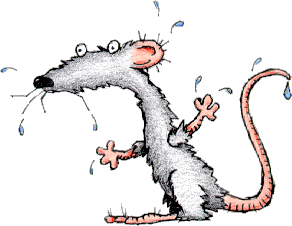Choosing a Healthy Rat
Even before you bring your rat home, you should check to make sure there are no obvious problems. Even seemingly minor sniffles can turn into something worse. If you get your rat from a petstore, the first thing to do is see what bedding it's on. If the rats are on pine or cedar bedding, most likely they will develop respiratory problems later in their life (if they haven't already). Some people haven't had problems if they bring their rat home and put it on better bedding, though it's always good to check. You should also see what kind of food they're on. Most pet stores will feed their rats any rat/mouse mix from a bag, because it is, after all, what they sell. Some pet stores feed their rats dry cat/dog food, but that is not a good choice. Not only will the rats not get the nutrition they need from that, but they will get rather fat. If you ask to hold the rat, take notice of how friendly it is, because that is often a result of how often they get handled by the pet store employees. You should also check for any porphyrin (also known as "red tears") around the eyes or nose, because that is a sign of illness or stress. Your rat's eyes should be bright and shiny, and it should be interested in its surroundings. Check its skin for scabs or bite marks, as they would indicate fleas or mites. You also might want to check its teeth, to make sure they're not chipped, or too long. Last but not least, listen to the rat's breathing. If it is labored and wheezy, the rat has already developed a respiratory problem. If you decide you absolutely can't live without that rat despite its health problems, be ready to fork over a large chunk of change to a vet.
For the first few days, your rat is going to want to chill out, and not be held much. It's best to place its cage in a quiet part of your house/apartment and only attempt to hold it or play with it when you feed it. If you choose to put your new rat in with rats you already own, you should quarantine your new rat for atleast two weeks. You should put it in a clean cage, prefferably not even in the same room as your other rats. Be sure to wash your hands before AND after handling your new rat. When setting up the cage, check to make sure nothing in it could injure your rat. If there are wire ladders or wheels, you might want to consider weaving paper in between the rungs so your rat can't get its feet caught. If you have wire levels in the cage, it would be better in the long run to cover it somehow, so your rat doesn't develop Bumblefoot, which can be very serious. I'll devote a section to bumblefoot later on. Also watch for the spacing of the bars on the cage - if they are set too far apart, your rat could easily slip through. If you have a wire mesh cage, be sure the spacing isn't so small your rat could get its feet caught.

|
|
Rats can very easily develop respiratory infections, including the dreaded Mycoplasma pulmonis otherwise known as Myco. There are a few ways to go about preventing some respiratory infections, though it is believed nothing can truly prevent Myco.
If your rat developes a repiratory infection, check to make sure none of the above apply, and take it immediately to a vet. Too often have I taken my rats to the vet only to find out they are too far gone in their sickness to be helped much.
| Everyone has different opinions on what rats should be fed. I feed my rats mostly lab blocks (a.k.a. rat pellets) because they contain the basic minerals and other healthy stuff rats need, and I'll also mix in a small amount of a rat seed mix. I do this because rats will pick and choose what they want from the seeds, and they're obviously going to pick the food that tastes good (sunflower seeds) yet that may not be too good for them. With my method of feeding, the rats get the diet they need, along with some tasty stuff. Usually I'll buy 2 bags of lab blocks (my rats prefer anything but the Kaytee brand) and mix it with one bag of rat and mouse seed mix. I also have a policy that every evening when I feed the rats, they get one yogurt drop each, along with some form of human food like celery, apple peels or peanuts. |

|
Other rat owners have many different preferred feeding habits. Unfortunately, some people just buy a bag of a store-brand rat food that is often way too high in its seed content, as well as "crude protein" - too much of which could make your rat fat. Other people (fewer in numbers, thankfully) will only feed their rat dog food. Dog food is exremely high in sodium and crude protein for such small animals, and rats fed a diet of dog food tend to develop weight problems easier. There are rat owners out there, however, who are marvelous chefs when it comes to rats. Ask anyone on the AOL rat message boards what they feed their rats, and you'll most likely get a list of what's okay and not (everyone's opinion is different) as well as what gets fed to which rats on what day, at what time, etc. Ask for a recipe and you'll get dozens.
As far as my opinions go on what's not suitable for rats, I've already discussed most of it. Dog food is a definate no-no (unless used for an occasional treat) but almost all human food is okay by me. The only things I won't feed my rats are peanut butter, bananas and oranges. There's nothing wrong with these foods in themselves, but more how the rats use them. Rats are so eager and excited when they get a treat, that they could choke on the peanut butter and bananas, (I hate learning by experience) and rats don't need the vitamin C found in oranges. Too much vitamin C could cause rats to get skin sores (as well as too much sodium, which limits the number of sunflower seeds I make available to my rats). Many people are unsure whether chocolate is alright for rats, so I'll give my opinions and experiences on the topic. In the past, I've given chocolate to all my rats, and not a single one has died from it. Some people believe that chocolate contains a certain chemical that will open the air passages in a rat's lungs or throat and allow them to breathe easier. I'm not so sure about that, but I don't believe chocolate is bad for rats as it is for dogs.
Rats have awfully small feet for their large body, so consequently there's a lot of weight on those small feet (especially hind feet). If those feet should for some reason get cut and infected, it can present a big problem. An easy way for this to happen is by walking on wire floors. Many cages sold in pet stores will have wire ladders, extra floors, or even a single-floor cage with a wire floor. I cringe when seeing that. Imagine living your live on a wire floor and not wearing any socks or shoes to protect yourself.
Bumblefoot starts out as a small red bump on the heel of the hind feet. If untreated, this can turn into a sore, and if it progresses even farther, it will bleed easily. I lost my rat Hamlet to bumblefoot, and it wasn't until afterwards that I learned how to treat it. His bumblefoot was so serious that he had a very large, swollen, purple sore on the back of his hind feet, and the slightest tug at the scabs covering the sores would cause them to burst out bleeding-usually at the mercy of my favorite shirts. He was in danger of dying of blood loss, but you'll have to visit his web page to see what our final solution was.
When my second male rat, Jeff got bumblefoot, we used a product called Blu-Kote, bought off the RMCA merchandise page. It was a very small price to pay for Jeff's health. By using this product (which I discovered appears blue under flourescent light, yet purple under normal light) Jeff's bumblefoot went away after a few weeks, and he never had a recurring problem. In his case, as well as Hamlet's, I believe he developed bumblefoot because they were big, beefy boys. Hamlet had been on wire when he was very young, but not since I had gotten him, and Jeff had never been on wire. For this reason, I advise you check your rats and REMOVE any wire in his/her cage.
There you have it for the health section of this web page. If you have any questions, comments, would like to see a section added to this page or quote a section for a report, feel free to e-mail me. Good health to you and your rats!
